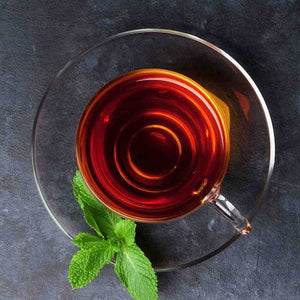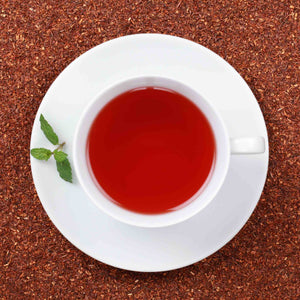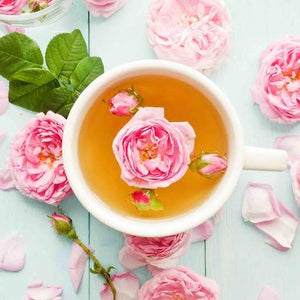Dictionary of Mintealogy

Dictionary of Mintealogy | Maison NANA1807
Welcome to the Maison NANA1807 Mintealogy Dictionary. Discover the essential terms of the art and science of Mint Tea, from A to Z. Perfect for tea enthusiasts and professionals alike, this lexicon will help you deepen your knowledge and fully appreciate each cup of

A
- Alkaloids: Natural chemical compounds found in tea leaves, such as caffeine.
- Aroma: Pleasant smell given off by an infusion of Mint Tea.
- Aquaculture: Method of growing Tea and Mint plants in an aquatic environment.
- Astringency: Sensation of dryness in the mouth often caused by the tannins present in certain teas.
B
- Blend: Mixture of different varieties of Tea and Mint to create a balanced and complex infusion.
- Bouquet: Set of aromas released by an infusion of Mint Tea.
- Broken: Pieces of tea leaves used in tea bags.
C
- Catechins: Type of antioxidants present in Tea, beneficial for health.
- Cold Brew: Brewing method using cold water to achieve delicate and refreshing aromas.
- Concentration: Degree of intensity of aromas and flavors in a Mint Tea infusion.
- Cultivar: Cultivated variety of Tea or Mint selected for its specific characteristics.
- Cuvée: Specific blend of different harvests of Tea and Mint.
D
- Decoction: Infusion technique where the leaves are boiled to extract more intense aromas.
- Distillation: Process used to extract essential oils from Mint.
- Dosage: Quantity of Tea and Mint leaves used to prepare an infusion.
- Drainage: Water management system in tea plantations to ensure optimum growth.
- Drying: Stage where the Tea and Mint leaves are dried to stop oxidation and preserve their aromas.
E
- Elaboration: Complete process of transforming Tea and Mint leaves into the final product.
- Emulsion: A stable mixture of two liquids, as in some Mint Tea preparations.
- Energy: Stimulating effect often sought in Teas based on Mint and Green or Black Tea.
- Enfleurage: Technique of extracting aromas by absorption in fats, used for certain varieties of Mint.
- Essential Oil: Concentrated aroma extracted from mint plants.
- Extraction: Process by which aromatic and taste compounds are released from Tea and Mint leaves during infusion.
F
- Flavor: Combination of flavors and aromas perceived when tasting Tea.
- Fermentation: Stage of transformation of tea leaves (notably for black tea and Oolong tea) where enzymes oxidize polyphenols, influencing the flavor and aroma.
- Flower: Part of certain varieties of Mint used for floral and delicate infusions.
- Flower Bud: Unopened part of the Tea or Mint plant, sometimes used for delicate infusions.
- Fragrance: Pleasant smell given off by Mint Tea.
G
- Glycosides: Natural chemical compounds found in Mint that contribute to its sweet taste.
- Grade: Classification of tea leaves according to their quality and size.
- Granulation: Process of transforming tea leaves into granules for rapid infusion.
- Grinding: Process of reducing tea leaves into small particles, often used for powdered tea.
H
- Harmonization: Creating a perfect balance between the different flavors in a Mint Tea blend.
- High-end: Superior quality of Mint Teas, often from renowned terroirs.
- Herbarium: Collection of plants from Tea and dried mint used for the study and comparison of varieties.
- Herbalism: Practice of collecting Tea and Mint plants in nature.
- Hygrometry: Measurement of humidity in the air, important for the conservation of Tea and Mint leaves.
- Harvesting: Action of collecting Tea and Mint leaves, essential for the quality of the final product.
I
- Infusette: Small bag containing tea and mint leaves, used for a quick infusion.
- Infuser: Accessory for holding tea and mint leaves during infusion.
- Infusion: Process consisting of leaving tea and mint leaves in contact with hot water to extract their aromas and flavors.
- Ingredient: An element added to tea blends to enrich the flavor, such as lemon or honey.
- Intensity: Level of concentration of aromas and flavors in an infusion.
J
- Japan: Country famous for its varieties of green tea, sometimes mixed with mint.
- Jasmine: Flower often added to tea blends to provide a floral note.
- Young Shoot: Tea leaf harvested early in the season, often more delicate and aromatic.
- Yellow: Color of certain mint tea infusions, especially those made with green tea.
K
- Kettle: Tool used to heat the water needed to brew tea.
- Kombucha: A fermented tea-based drink, often flavored with mint for a refreshing flavor.
- Kefir: A fermented tea drink, sometimes flavored with mint for a refreshing taste.
- Kiosk: Stand or shop specializing in the sale and tasting of tea.
- Kukicha: Japanese tea made from stems and leaves, sometimes mixed with mint.
L
- Leaf: Part of the Tea or Mint plant used for infusion.
- Lapsang Souchong: Smoky black tea that can be mixed with mint for a unique taste.
- Lightness: Quality of a mint tea infusion that is neither too strong nor too heavy.
- Liqueur: Liquid resulting from the infusion of Tea and Mint leaves, characterized by its color, aroma, and taste.
- Luster: Shiny, attractive appearance of tea leaves before brewing.
M
- Maceration: Technique where tea and mint leaves are steeped in cold water to extract the aromas.
- Matcha: Powdered Japanese green tea, sometimes mixed with mint to create an energizing and refreshing drink.
- Maturation: Period during which tea leaves are aged to develop their aromas.
- Menthol: The main aromatic compound in mint, responsible for its refreshing flavor.
- Mintéalogie: The study of the science, history, culture, and art of Mint Tea and its benefits.
- Mintéalogue: Expert in Mintéalogie - Specialist in Mint Tea, expert in Tea growing and Theification, responsible for the composition, analysis, and tasting of Mint Teas.
- Mint Tea Master: Expert in the creation and tasting of high-quality Mint Teas.
N
- NâNâ: Moroccan mint (Mentha spicata), essential for Moroccan Mint Tea, known for its fresh and intense aroma.
- Nebulization: Technique used to lightly humidify tea leaves before infusion to preserve their aromas.
- Nectar: Particularly sweet and mild mint tea infusion.
- Nose: Set of aromas perceived from the infusion of Mint Tea.
- Nuances: Different shades of color and taste in a mint tea infusion.
- Notes: Subtle variations in aromas and flavors perceived when tasting mint tea.
O
- Oolong: A type of partially oxidized tea, sometimes mixed with mint for a unique infusion.
- Organic Farming: A method of growing crops without the use of pesticides or chemical fertilizers.
- Origin: Place where Tea and Mint plants are grown, influencing their quality and aromatic profile.
- Osmosis: Process of diffusion of aromas and flavors of Tea and Mint leaves into water during infusion.
- Oxidation: Chemical reaction that occurs when tea leaves are exposed to air, influencing the color and flavor of the tea.
P
- Preparation: Set of steps necessary to correctly infuse Mint Tea.
- Powder: A form of tea where the leaves are finely ground, as with matcha.
- Purity: Quality of a Mint Tea without contaminants or additives.
- Planter: A person who cultivates tea and mint plants.
- Plucking: A technique of harvesting Tea and Mint leaves, often involving hand-picking to ensure superior quality.
Q
- Quality: Level of excellence of a mint tea, determined by the selection of leaves, the production process, and the sensory characteristics.
- Quantity: Measure of tea and mint leaves used for infusion.
- Quest: Continuous research into the best varieties and methods to produce high-quality mint tea.
- Quay: Place where tea leaves are stored before processing.
- Quinquina: Bark sometimes used in infusions for its bitter and medicinal properties.
R
- Refreshing: Quality of a Mint Tea which provides a sensation of freshness in the mouth.
- Harvest: Period and method of collecting Tea and Mint leaves.
- Dress: Color and visual appearance of the infusion of Mint tea.
- Roastery: Place or action of heating tea leaves to stop oxidation and develop aromas.
- Rolling: Process of rolling tea leaves to release their essential oils and facilitate infusion.
- Retro-olfaction: Sensation of aromas perceived after swallowing the infusion.
- Robustness: Strength and intensity of the aromas and flavors of a Mint Tea.
S
- Selection: Choice of the best Tea and Mint leaves to create quality blends.
- Scent: Pleasant smell emanating from Mint Tea.
- Saponins: Natural compounds present in certain Tea and Mint plants, known for their foaming properties.
- Greenhouse: Structure used for growing Tea and Mint plants under controlled conditions.
T
- Tannins: Compounds found in tea leaves that contribute to the astringency and structure of the infusion.
- Temperature: Degree of heat used during the infusion process, affecting the final taste and aroma.
- Terroir: Environmental factors that influence the flavor and quality of Tea and Mint, such as soil, climate, and altitude.
- Theine: Synonym for caffeine, present in tea and providing a stimulating effect.
- Tea Growing: Cultivation and maintenance of tea plants, including variety selection, plantation management, and harvesting methods.
- Teaification: The process of transforming tea leaves from harvest to the final product ready for infusion, including the stages of withering, rolling, oxidation, drying, and sorting.
- Twisting: Action of twisting tea leaves to extract essential oils.
U
- Umami: A taste sensation that can be present in some teas, adding depth to the flavor profile of Mint Tea.
- Uplift: Effect of certain Mint Teas in boosting mood or energy.
- Unfolding: The process of opening tea leaves to improve infusion.
V
- Varietal: Specific type or variety of Tea or Mint plant, often contributing unique flavors.
- Vintage: Year of harvest of tea leaves, which can affect the flavor and quality of the infusion.
W
- Withering: Initial step in tea processing where the leaves are allowed to wilt, reducing moisture content.
- Water Quality: The purity and mineral content of water used for infusion, which can affect the taste of Mint Tea.
- Winnowing: Process of removing stems and other debris from tea leaves after harvesting.
X
- Xanthines: Class of compounds that include caffeine, theobromine, and theophylline, found in tea leaves.
Y
- Young Shoot: Tea leaf harvested early in the season, often more delicate and aromatic.
- Yellow: Color of certain mint tea infusions, especially those made with green tea.
Z
- Zen: A state of calm and relaxation often sought when enjoying an infusion of mint tea.
- Zest: Aromatic outer layer of citrus fruits sometimes added to Mint Tea blends for extra flavor.
- Zinc: Mineral present in certain tea infusions, contributing to health benefits.
- Zymology: Science of fermentation, relevant to fermented teas like kombucha, sometimes flavored with mint.
- Zhou Gui: A variety of Chinese Oolong tea, sometimes prized for its unique taste and potential to be blended with mint.
Why choose Maison NANA1807?
The Maison NANA1807 is dedicated to the preservation and promotion of the art of
Join us on social media for tasting tips, exclusive recipes and special offers:
Contact us for more information or to discover our collection of Mint Teas.




